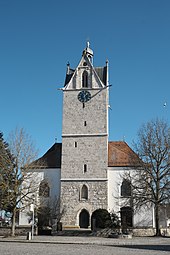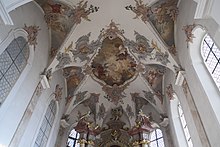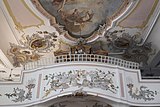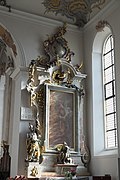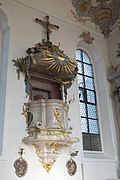St. Martin (Altheim near Riedlingen)
The Catholic parish church of St. Martin in Altheim , a municipality in the Biberach district in Baden-Württemberg , is a late Gothic church building from the 15th century that was redesigned in the late Baroque or Rococo style in the middle of the 18th century . At the beginning of the 20th century, the church was expanded to include a transept and an extension to the west. Of the Gothic church, only the bell tower, the choir and the sacristy , a former chapel , are preserved today. The church is dedicated to St. Martin of Tours .
history
The parish Altheim was mentioned in writing as early as 1227 . The Martinskirche is mentioned for the first time in a document in 1318. The tower, which dates back to the 14th century in its basement, is the oldest part of the church. The current church was built towards the end of the 15th century and consecrated in 1486. The year 1496 in the tower probably refers to the year the tower was completed. In the years 1744 to 1750 the church was baroque and redecorated. The sculptor and plasterer Joseph Anton Feuchtmayer (1669–1770) from Linz was commissioned with the execution of the stucco decoration , and the painter Franz Josef Spiegler (1691–1756) from Wangen im Allgäu , who also created the ceiling paintings in the former Benedictine monastery church of Unserer , for the ceiling paintings Dear woman in Zwiefalten . In the years 1908 to 1911 the church was expanded with a transept and the two side extensions were added to the tower in the west.
architecture
Bell tower
In front of the west facade is the three-storey tower, the four gable ends of which are crowned by finials and broken up by pointed-arched tracery windows. The tower is of two intersecting gable roofs covered, open their intersection lantern is constructed. A pointed arch niche with the figure of the patron saint, St. Martin, and a pointed arch portal with a modern bronze door are cut into the base of the tower .
inner space
The single-nave nave is covered by a flat ceiling over coves . The choir has a mirror vault with stitch caps. The western extension with its gallery , completed in 1911, is based on the late baroque style.
Starvation
During the restoration of the church in the 1960s, three pieces of divided canvas were discovered on the back of the altar paintings, which had apparently been attached to protect against moisture. The canvas with its late Gothic painting is a hunger or lent cloth that was hung in the choir during Lent and was intended to cover the altar. The origin of the Altheimer Lenten cloth is believed to be around 1500. Ten picture fields can be seen on the canvas fragments, which are arranged in two superimposed rows of five fields each. The original hunger cloth probably consisted of six rows of five pictures each. It was believed to have been 6.20 meters by 8.5 meters and three times the size of the preserved fragment. The following scenes are shown on the ten image fields:
- Adam under the tree of life
- Eve hands Adam the apple
- Expulsion from Paradise
- Adam works the field and Eve spins
- Annunciation
- Adoration of the child by Mary and Joseph
- clipping
- Adoration by the Magi
- Killing the Innocent Children
- Escape to Egypt
Further equipment
- The altars are works by Joseph Anton Feuchtmayer.
- Choir stalls and pulpit also date from the Baroque era of the church.
Web links
- Parish Church of St. Martin & Altheimer Hungertuch Upper Swabia's sights
- Parish Church of St. Martin Altheim parish
- Altheim LEO-BW
Individual evidence
- ^ The Altheim hunger cloth community Altheim
Coordinates: 48 ° 8 ′ 39.8 " N , 9 ° 26 ′ 53.9" E
